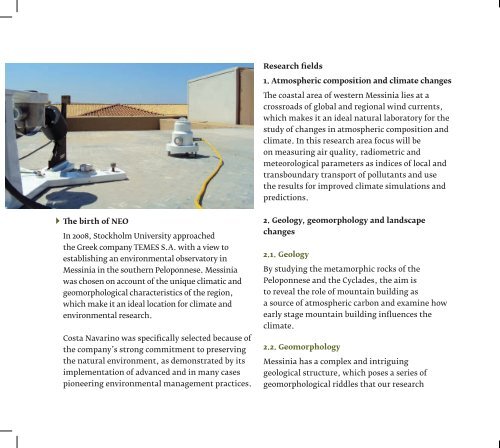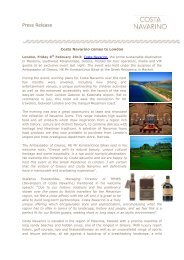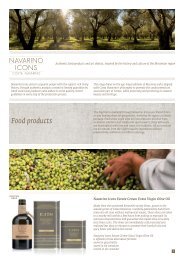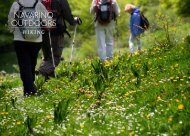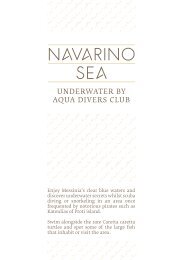NEO Brochure - Costa Navarino
NEO Brochure - Costa Navarino
NEO Brochure - Costa Navarino
Create successful ePaper yourself
Turn your PDF publications into a flip-book with our unique Google optimized e-Paper software.
The birth of <strong>NEO</strong><br />
In 2008, Stockholm University approached<br />
the Greek company TEMES S.A. with a view to<br />
establishing an environmental observatory in<br />
Messinia in the southern Peloponnese. Messinia<br />
was chosen on account of the unique climatic and<br />
geomorphological characteristics of the region,<br />
which make it an ideal location for climate and<br />
environmental research.<br />
<strong>Costa</strong> <strong>Navarino</strong> was specifically selected because of<br />
the company’s strong commitment to preserving<br />
the natural environment, as demonstrated by its<br />
implementation of advanced and in many cases<br />
pioneering environmental management practices.<br />
Research fields<br />
1. Atmospheric composition and climate changes<br />
The coastal area of western Messinia lies at a<br />
crossroads of global and regional wind currents,<br />
which makes it an ideal natural laboratory for the<br />
study of changes in atmospheric composition and<br />
climate. In this research area focus will be<br />
on measuring air quality, radiometric and<br />
meteorological parameters as indices of local and<br />
transboundary transport of pollutants and use<br />
the results for improved climate simulations and<br />
predictions.<br />
2. Geology, geomorphology and landscape<br />
changes<br />
2.1. Geology<br />
By studying the metamorphic rocks of the<br />
Peloponnese and the Cyclades, the aim is<br />
to reveal the role of mountain building as<br />
a source of atmospheric carbon and examine how<br />
early stage mountain building influences the<br />
climate.<br />
2.2. Geomorphology<br />
Messinia has a complex and intriguing<br />
geological structure, which poses a series of<br />
geomorphological riddles that our research<br />
project will attempt to solve, while analyzing the<br />
landscape changes that have occurred in Messinia<br />
in the recent 100 000 years, as well as at longer<br />
time perspectives.<br />
3. Present and past climate, water and<br />
environmental changes<br />
3.1. Water research<br />
In this research focus will mainly be on coastal<br />
aquifers, the quantification and management<br />
options for water quantity and quality in coastal<br />
regions, under consideration of increasing tourism<br />
and/or urbanization pressures. The area of Gialova<br />
Lagoon will be used as a case study.<br />
3.2. Dendroclimatology<br />
The annual rings in trees constitute archives<br />
holding a record of the climatic and environmental<br />
conditions that prevailed during their growth.<br />
Timbers recovered from old buildings,<br />
archaeological sites or from geological/biological<br />
sediments collected from all over Greece will be<br />
studied to increase our understanding on climatic<br />
evolution and variability in the Mediterranean<br />
area.


